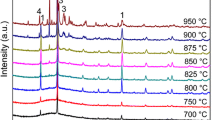The structure of the surface layer of ceramic composite materials (CCM) with the compositions HfB2–SiC and SiC–TiC after exposure to a flow of dissociated air was investigated. X-ray structural analysis of the surface and analysis of the microstructure of the surface layer by means of scanning and transmission electron microscopy were performed. The features of the formation of glassy layers on the surface of CCM with refractory oxides distributed in them are shown. The interior volume of the materials contains unoxidized initial components.






Similar content being viewed by others
References
V. A. Zhabrev, M. V. Sazonova, L. P. Efimenko, et al., “Kinetics of formation of glass-ceramic thermostable coatings,” Fiz. Khim. Stekla, 32(1), 106 – 115 (2006).
S. S. Solntsev, N. V. Isaeva, G. V. Ermakova, et al., “High-temperature coating, Pat. 2253638 RF,” Byull. Izobr. Polezn. Modeli, No. 16 (2005).
C. Cabet, “Review: Oxidation of SiC/SiC composites in low oxidizing and high temperature environment,” in: Materials Issues for Generation IV Systems, Springer Science + Business Media B.V. (2008), pp. 351 – 366; DOI 10.1007/978-1-4020-8422-5.
E. P. Simonenko, N. P. Simonenko, A. N. Gordeev, et al., “Study of the thermal behavior of wedge-shaped samples of ultrahigh- temperature composite material HfB2– 45 vol.% SiC in a high-enthalpy air flow,” Zh. Neorg. Khim., 63(4), 393 – 404 (2018); DOI https://doi.org/10.7868/S0044457X18040013.
N. Al Nasiri, N. Patra, Na Ni, et al., “Oxidation behavior of SiC_SiC ceramic matrix composites in air,” J. Europ. Ceram. Soc., 36(14), 3293 – 3302 (2016).
E. P. Simonenko, A. N. Gordeev, N. P. Simonenko, et al., “Investigation of the behavior of ceramic materials HfB2– SiC (10, 15 and 20 vol.%) in flows of high-enthalpy air,” Zh. Neorg. Khim., 61(10), 1259 – 1275 (2016); DOI https://doi.org/10.7868/S0044457X16100172.
O. Yu. Sorokin, D. V. Grashchenkov, S. St. Solntsev, et al., “Ceramic composite materials with high oxidation resistance for advanced aircraft (review),” Tr. VIAM: Elektron. Nauch.-Tekhn. Zh., No. 6, Art. 08 (2014); URL: http://www.viam-works; DOI 10.18577/2307-6046-2014-0-6-8-8.
V. G. Sevast’yanov, E. P. Simonenko, N. P. Simonenko, et al., “Synthesis of nanostructured silicon through the gas phase using perchlorosilanes for doping a high-temperature composite material based on silicon carbide,” Tr. VIAM: Elektron. Nauch.-Tekhn. Zh., No. 4, Art. 04 (2014); URL: http://www.viam-works.ru; DOI 10.18577/2307-6046-2014-0-4-4-4.
A. S. Chainikova, L. A. Orlova, N. V. Popovich, et al., “Dispersion-strengthened composites based on glass/glass-crystalline matrices: properties and applications (review),” Aviats. Mater. Tekhnol., No. 3, 45 – 54 (2014); DOI 10.18577/2071-9140-2014-0-3-45-54.
A. S. Chainikova, L. A. Orlova, N. V. et al., “Functional composites based on glass_glass-crystalline matrices and discrete fillers: properties and applications (review),” Aviats. Mater. Tekhnol., No. S6, 52 – 58 (2014); DOI 10.18577/2071-9140-2014-0-s6-52-58.
A. N. Gordeev and A. F. Kolesnikov, Actual Problems of Mechanics: Physical and Chemical Mechanics of Liquids and Gases [in Russian], Nauka, Moscow (2010), pp. 151 – 177.
E. N. Kablov, B. E. Zhestkov, D. V. Grashchenkov, et al., “Investigation of the oxidation resistance of a high-temperature coating on a SiC-material under the influence of a high-enthalpy flow,” Teplofiz. Vys. Temp., 55(6), 704 – 711 (2017); DOI https://doi.org/10.7868/S0040364417060059.
B. E. Zhestkov, M. L. Vaganova, Yu. E. Lebedeva, et al., “Influence of nitrogen high-speed flow impact on the structure and chemical composition of high-temperature coating on SiC composite,” High Temperature, 56(3), 378 – 381 (2018) [Teplofiz. Vys. Temp., 56(3), p. 395 – 398; DOI 10.1134/S0018151X18030215].
N. A. Toropov, V. P. Barzakovskii, V. V. Lapin, et al., Handbook of Phase Diagrams of Silicate Systems, No. 1, Binary Systems [in Russian], Nauka, Leningrad (1969).
C. DeCapitani and M. Kirschen, “A generalized multicomponent excess function with application to immiscible liquids in the system CaO–SiO2–TiO2,” Geochim. Cosmochim. Acta, 62(23_24), 3753 – 3763 (1998); DOI 10.1016/S0016-7037(98)00319-6.
S. A. Kirillova, V. I. Almyashev, and V. V. Gusarov, “Spinodal decomposition in the SiO2–TiO2 system and the formation of hierarchically organized nanostructures,” Nanosistemy: Fiz., Khim., Matem., 3(2), 100 – 115 (2012).
M. A. Pugachevskii, Stabilization of Nanoparticles of Oxides of Group-IV Transition Metals during Laser Ablation, Author’s Abstract of Doctoral’s Thesis [in Russian], Kursk (2016).
R. C. Garvie, “The occurrence of metastable tetragonal zirconia as a crystallite size effect,” J. Phys. Chem., 69(4), 1238 – 1243 (1965); DOI https://doi.org/10.1021/j100888a024.
R. C. Garvie, “Stabilization of the tetragonal structure in zirconia microcrystals,” J. Phys. Chem., 82(2), 218 – 224 (1978); DOI https://doi.org/10.1021/j100491a016.
O. Hunter, “Characterization of metastable tetragonal hafnia,” Ceramurg. Int., 5(4), 137 – 142 (1979); DOI https://doi.org/10.1016/0390-5519(79)90021-8.
D. Fischer, “Stabilization of the high- k tetragonal phase in HfO2: The influence of dopants and temperature from ab initio simulations,” J. Appl. Phys., 104(8), 84104 (2008); DOI 10.1063/1.2999352.
J. Aarik, A. Aidla, H. Mandar at al., “Phase transformations in hafnium dioxide thin films grown by atomic layer deposition at high temperatures,” Appl. Surf. Sci., 173(1 – 2), 15 – 21 (2001); DOI 10.1016/S0169-4332(00)99859-X.
H. Kim and P. C. McIntyre, “Spinodal decomposition in amorphous metal–silicate thin films: Phase diagram analysis and interface effects on kinetics,” J. Appl. Phys., 92(9), 5094 – 5102 (2002); DOI https://doi.org/10.1063/1.15110590.
E. N. Kablov, “Innovative developments of the Federal State Unitary Enterprise VIAM SSC RF for the implementation of ‘Strategic directions of development of materials and technologies for their processing for the period up to 2030’,” Aviats. Mater. Tekhnol., No. 1, 3 – 33 (2015); DOI 10.18577/2071-9140-2015-0-1-3-33.
E. N. Kablov, “Strategic directions for the development of materials and technologies for their processing for the period up to 2030,” Aviats. Mater. Tekhnol., No. S, 7 – 17 (2012).
Author information
Authors and Affiliations
Corresponding author
Additional information
Translated from Steklo i Keramika, No. 6, pp. 8 – 15, June, 2021.
Rights and permissions
About this article
Cite this article
Zhuravleva, P.L., Lutsenko, A.N., Lebedeva, Y.E. et al. Formation of a Glass Layer in Ceramic Composite Materials as a Result of Exposure to High-Enthalpy Flow. Glass Ceram 78, 219–225 (2021). https://doi.org/10.1007/s10717-021-00383-z
Published:
Issue Date:
DOI: https://doi.org/10.1007/s10717-021-00383-z




